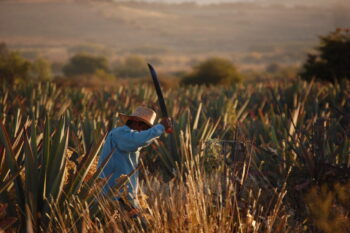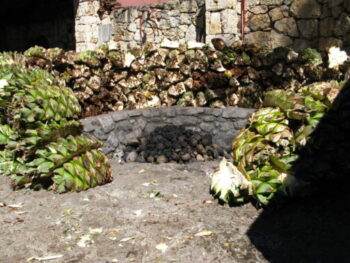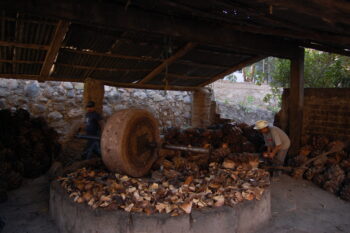
THE LAST OF THE WORLD’S GREAT SPIRITS
All cognacs, rums, whiskies were once made entirely by artisanal methods. Now almost all of them are made with semi-industrial equipment and sold as commodities. Mezcal is the last truly great spirit holdout

Espadín agaves near Santiago Matatlan
Mezcals are distilled from agaves, complex plants that take years to mature.

clay pot still at Don Amado's palenque
All great mezcals are distilled using artisanal or ancestral methods

Trimming the spears from an agave piña near Santiago Matatlan
Mature agaves, weighing up to 200 pounds, are harvested and trimmed by hand and brought by truck or burro to the distillery.

Cut-up agaves about to be put in the pit oven at Los Danzantes
Agaves, cut up if big, are roasted, often in below-ground wood-fired pit ovens. Roasting converts the carbohydrates in agaves to sugars. The same process happens when you roast an ear of corn.

Stone “egyptian” mill in San Juan del Rio
Roasted agaves are cut into smaller pieces and crushed/milled, releasing the liquids and making the sugars accessible to yeasts.

Pinewood fermentation vats (tinas) - at Los Danzantes
The milled solids and liquids are moved to fermentation tanks.

A rich fermentation at Don Valente Angél’s palenque, San Andrés
Airborne wild yeasts convert the sugars into alcohols. This can take two weeks. You can see the activity by the slow bubbles of CO2 released by the working yeasts.

All of the fermented agave is put into the still, liquids and solids both. Tequila leaves the solids out.

Angel Cruz Robles tasting for the tails cut at his palenque near Sola de Vega
Most mezcals are distilled twice. At the beginning and end of distillation, alcohols that don’t taste good or are toxic can be separated (the word is “cut”).

fresh from the still at Eduardo Hernández’ palenque, Santa Ana del Rio
Finished mezcal is clear. The agave aromas and flavors have been purified, concentrated, and made more complex. If the distiller knows what he’s doing, his mezcal has clean, rich, and distinctive flavors and aromatics.
Agaves can yield spirits at the quality level of the finest cognacs, whiskies, rums . Mezcals are truly the last of the world’s great spirits.